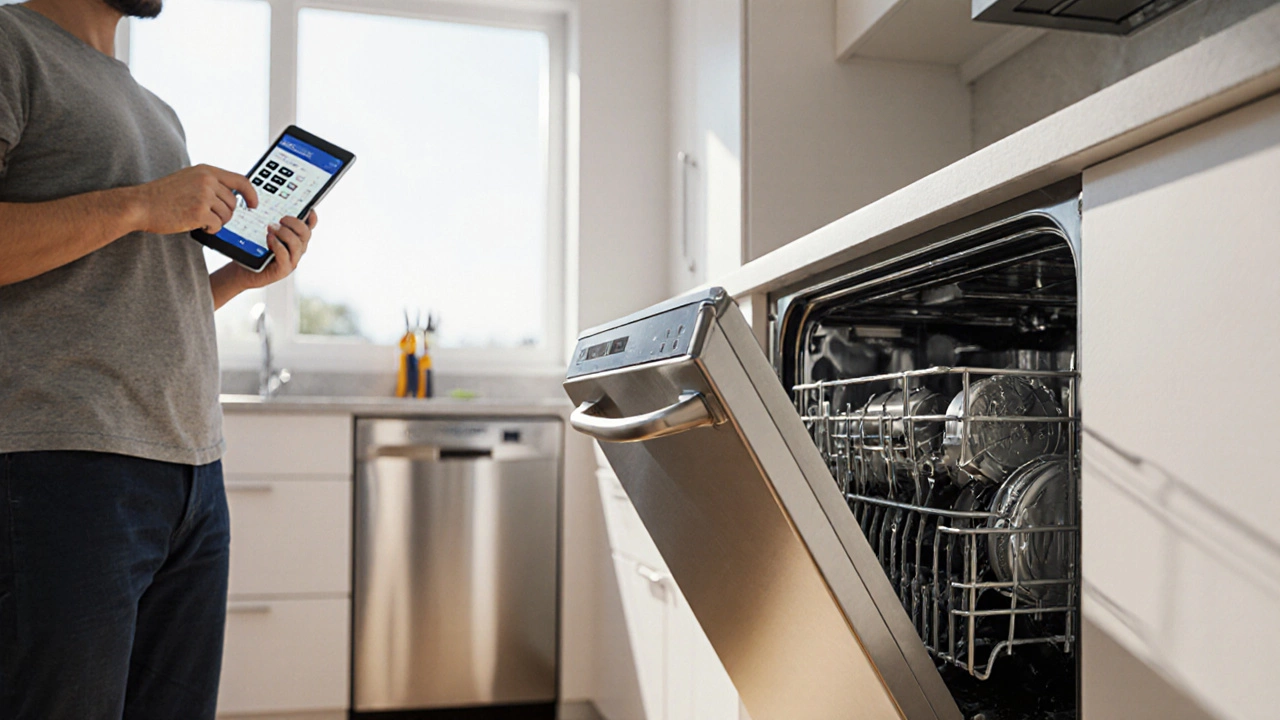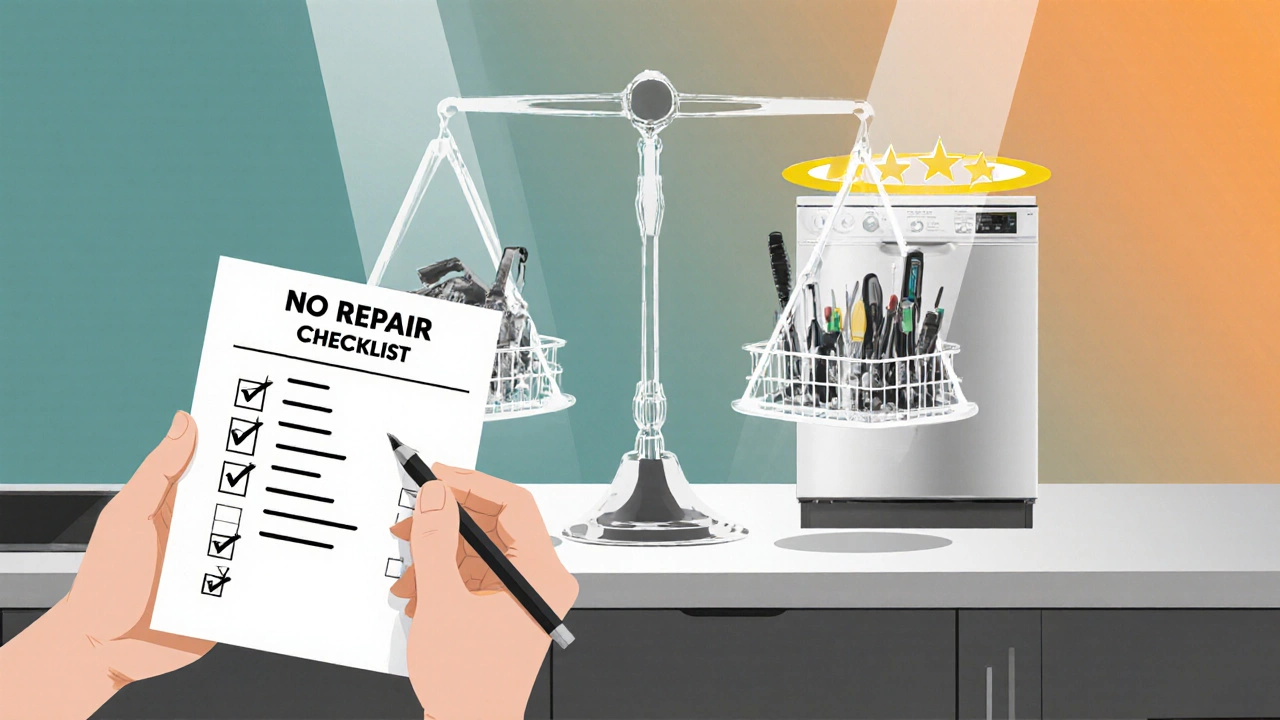
Dishwasher Repair vs Replace Calculator
Enter Your Dishwasher Details
Result
points scored out of 9
Key Factors
Dishwasher is a built‑in kitchen appliance that automatically washes, rinses, and dries dishes. When it starts acting up, the first question most homeowners ask is whether fixing it will save money or if buying a new unit is the smarter move. The answer isn’t one‑size‑fits‑all - it depends on age, fault type, energy rating, and even your local labour rates. This guide walks you through every cost factor, shows you how to crunch the numbers, and gives a quick checklist so you can decide without endless Googling.
Key Takeaways
- If the repair bill is under dishwasher repair cost of $150 and the machine is less than eight years old, fixing usually wins.
- Older models (9+ years) often waste more water and electricity, so a replacement can pay for itself in energy savings.
- Complex issues - like motor failure or electronic control board problems - tend to cost $300‑$600, edging close to the price of a mid‑range new unit.
- Check warranty coverage and any extended service plans; they can shave $50‑$200 off repair expenses.
- Use the quick decision checklist at the end to avoid costly guesswork.
Breaking Down the Numbers
Before you compare repair versus replacement, understand what you’re actually paying for. The two main cost buckets are:
- Repair cost - includes labour, parts, and any diagnostic fees.
- Replacement cost - the purchase price plus delivery, installation, and disposal of the old unit.
Below is a typical cost range for a standard 24‑inch built‑in dishwasher in the UK (prices converted to GBP). Numbers vary by brand and region, but they give a solid baseline.
| Cost Item | Typical Range | What It Covers |
|---|---|---|
| Labour | £70‑£120 | Technician time, travel, diagnostic fee |
| Common Parts | £30‑£150 | Spray arm, pump seal, door latch, sensor |
| Major Parts | £200‑£500 | Motor, heating element, electronic control board |
| Full Repair | £120‑£650 | Labour + parts (any combination) |
| New Mid‑Range Dishwasher | £350‑£700 | Appliance + basic installation |
| Premium Model | £900‑£1,500 | High‑efficiency, smart connectivity, extended warranty |
| Disposal & Recycling | £20‑£40 | Removal of old unit, eco‑fee |
When Repair Makes Sense
Repair is usually the cheaper route when the following conditions apply:
- Age - The dishwasher is younger than eight years. Most manufacturers’ warranties last three years, and many extended plans cover up to five.
- Problem Type - It’s a simple mechanical issue (clogged spray arm, broken latch, faulty door seal). These parts are inexpensive and easy to replace.
- Labour Rates - You have access to a reputable local repair service that charges under £80 per hour.
- Energy Rating - The unit already has a high energy rating (A+ or above). Swapping to a newer model may not yield huge electricity savings.
Example: A 2019 Bosch series 6 dishwasher develops a leaky door seal. The seal costs £45, labour £80, total £125. A new dishwasher of similar specs runs about £650. Repair saves you over £500.
When Replacement Pays Off
Sometimes the math flips, especially when the appliance is on its last legs. Replace instead of repair if:
- Age - More than nine years old. At this point, the machine’s core components are likely to fail again soon.
- Major component failure - Replacing the motor or control board alone can cost £300‑£500, which is a big chunk of a new dishwasher’s price.
- Energy efficiency gap - Older machines often sit at D or E energy ratings, meaning higher water and electricity bills. A new A+++ model can cut utility costs by 30‑40 %.
- Frequent breakdowns - If you’ve had two or more repairs in the past 24 months, the cumulative cost often exceeds the price of a new unit.
- Available rebates - In England, the latest Energy‑Saving Boiler Scheme (ESBS) and other local incentives may offer up to £150 off a high‑efficiency dishwasher.
Scenario: A 2008 Miele Classic dishwasher’s motor burns out. Motor replacement £420, labour £90 = £510. A comparable new Miele EcoFlex model costs £950 but saves roughly £120 per year on energy. In five years you recoup the extra expense.
Hidden Factors That Influence the Decision
Beyond the obvious price tags, three less‑obvious elements often tip the balance:
- Warranty Coverage - If your unit is still under manufacturer warranty or you own an extended service plan, the out‑of‑pocket repair cost may drop dramatically.
- Water Usage - Newer dishwashers use 12‑15 L per cycle versus 20‑25 L for older models. Over a typical UK household’s 220 cycles a year, that’s a noticeable water bill reduction.
- Installation Complexity - Some repairs require you to move the appliance, which adds labour time. Similarly, installing a new dishwasher may involve plumbing modifications that increase costs.

Quick Decision Checklist
Print this out or keep it on your phone. Tick each box and total the scores to see which side wins.
- Age under 8 years - Yes (2 points)
- Problem is a simple part (seal, spray arm) - Yes (2 points)
- Estimated repair cost under £150 - Yes (2 points)
- Energy rating already A+ or higher - Yes (1 point)
- Warranty or service plan still valid - No (0 points)
- Two or more repairs in past 24 months - No (0 points)
If you score 7 + points, repair is likely cheaper. Below 4 points, start shopping for a replacement.
Frequently Asked Questions
How much does a typical dishwasher repair cost in the UK?
For most common issues - such as a faulty door latch, spray arm, or pump seal - you can expect to pay between £120 and £250. Major component failures like a motor or electronic board can push the bill to £400‑£650.
Is it worth replacing a dishwasher that’s more than ten years old?
Generally yes. Ten‑year‑old units often have poorer energy ratings and higher water usage. Even if a repair costs £300, a new A+++ model may save £120‑£150 per year on utilities, meaning you break even in two to three years.
Do I need a professional to replace a dishwasher, or can I DIY?
If you’re comfortable turning off the mains water and electricity, and your new unit fits the existing cut‑outs, a DIY swap is doable. However, many insurance policies require a certified installer for warranty purposes, and improper connections can cause leaks or electrical hazards.
Can I get a discount on a new dishwasher through energy‑saving schemes?
Yes. England’s latest Energy‑Saving Boiler Scheme and local council programmes often provide vouchers up to £150 for appliances that meet A+++ energy standards. Check your council’s website for eligibility.
What’s the average lifespan of a modern dishwasher?
Most manufacturers rate their dishwashers for 10‑12 years of regular use. Proper maintenance - cleaning filters, running hot cycles monthly, and descaling - can extend that to 15 years.
Bottom line: run the numbers, weigh the hidden costs, and use the checklist. If the repair price stays well below the cost of a comparable new model and the appliance isn’t ancient, fixing it will save you money. Otherwise, a fresh, energy‑efficient dishwasher often pays for itself in lower bills and fewer headaches.